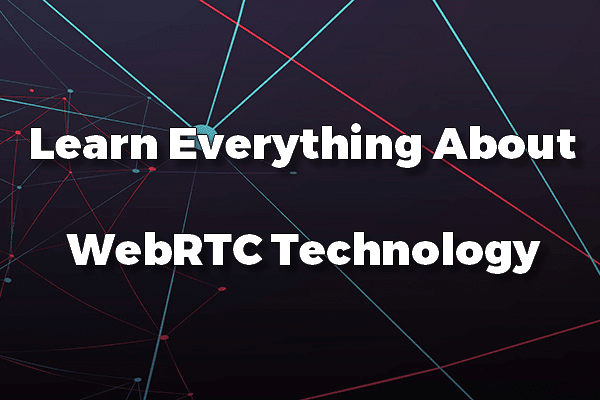Companies and contact centers have been compelled to modify their way of communication as a result of the digital revolution that has been taking place for some years, and the field of telecommunications is no exception!
In terms of technical developments and discoveries, the telecommunications business is really highly active. These evolutions, of which WebRTC is a part, enable the ongoing improvement of remote communications by making new and adaptable capabilities available to the market.
Telephony is a communication technology that is constantly reinventing itself in businesses. If its use is not diminishing, it is mostly due to the technology’s ability to develop in response to new usage habits and user demands. Fixed phones in offices are gradually losing their way to headsets connected to computers, which is clearly related to WebRTC. Discover the full explanation of this technology, its benefits, why it has the edge over normal SIP, and how to succeed with the migration.
What is WebRTC Technology?
 WebRTC, which stands for Web Real-Time Communications, is a technology that you may include on your website. It enables anybody with a suitable VoIP web application to use their browser to make outgoing calls, answer incoming calls, or hold video conferences.) WebRTC is an open standard that allows browsers and other web apps to communicate in real-time. This technique streamlines the experience of using Voice Over IP! There is no longer any requirement to download a special program that was previously required to interact over the Internet. With WebRTC, you will be able to clear up storage space on your PC while still communicating without the need for additional applications. WebRTC provides several advantages for everyone in your business, whether you are a user, administrator, or customer experience expert.
WebRTC, which stands for Web Real-Time Communications, is a technology that you may include on your website. It enables anybody with a suitable VoIP web application to use their browser to make outgoing calls, answer incoming calls, or hold video conferences.) WebRTC is an open standard that allows browsers and other web apps to communicate in real-time. This technique streamlines the experience of using Voice Over IP! There is no longer any requirement to download a special program that was previously required to interact over the Internet. With WebRTC, you will be able to clear up storage space on your PC while still communicating without the need for additional applications. WebRTC provides several advantages for everyone in your business, whether you are a user, administrator, or customer experience expert.
WebRTC is now supported by a number of browsers, including Firefox, Safari, and Google Chrome. To make a call, all your agents will need is an updated browser! Thanks to WebRTC, they may communicate visual and audible information, as well as share files.
WebRTC is intended for what kind of customer contact center?
This technology is aimed at all businesses and contact centers. To put it simply, WebRTC is aimed at businesses whose employees have PCs with a USB port or Bluetooth to attach a headset and a reliable Internet connection. The requirements for using WebRTC are minimal, making this technology accessible to the majority of people!
Benefits for Contact Centers
- Usability: One of the initial benefits of WebRTC is its ease of usage. In fact, it enables you to easily fluidify your trades due to its natural inclusion in the heart of web browsers.
- A high degree of adaptability: It may be accessed from any location and device. For instance, from your computer, cell phone, or tablet.
- New communication services: This technology enables the direct integration of various communication channels into its apps and online services. For example, it allows users to contact customer support straight from the provider’s mobile application.
- Productivity gains: Because it encourages telecommuting, it is a cutting-edge technology that is easily adaptable to new methods of working. It increases productivity for both your staff and your IT team.
- Excellent service quality: WebRTC manages the limits and issues that might arise on the Internet network. It guarantees that the communication flow adapts to the network quality thanks to its technical components. Furthermore, it ensures the control of interruptions as well as the treatment of echoes.
- Cost savings: WebRTC significantly saves infrastructure and maintenance expenses (when compared to a PBX2 or Centrex3 system) because it is directly hosted on the Web. WebRTC also reduces communication expenses, which is a substantial saving. Because, unlike DID technology or SIP telephony, no phone call is made, the expenses of employing WebRTC are cheaper when compared to alternative techniques.
- Simplify call administration in contact centers: WebRTC makes it easier to administer the customer interaction management platform. IT and customer service teams gain autonomy since they no longer need to request a DID number from an integrator or operator. Using the contact center solution with WebRTC, teams may simply dispatch calls to new agents without requiring external involvement to maintain contact center administration.
All of these features make WebRTC an excellent tool for a contact center that wants to :
- Keep their remote agents engaged,
- Manage communications for multi-site businesses,
- Streamline telephone conversations in their businesses,
- and minimizing associated expenses. These are all benefits that are causing many businesses to leave more traditional methods.
The truth is that when you see all these advantages that this technology offers. You might be inclined to think that there are many similarities between WebRTC and SIP, as both are used to provide simple and easy collaboration and communication through an Internet connection. However, they also have many differences. In fact, many think that WebRTC is just a refinement of the classical SIP, but this is not the case. Before explaining the differences, we must emphasize that they are not competing technologies.
WebRTC vs. SIP: Who has the edge?
 The most frequent questions that users ask today when choosing a VoIP telephony system have to do with the differentiation between these two terms. This will allow you to evaluate what is best for your business and avoid making a wrong choice that you may regret later.
The most frequent questions that users ask today when choosing a VoIP telephony system have to do with the differentiation between these two terms. This will allow you to evaluate what is best for your business and avoid making a wrong choice that you may regret later.
SIP (Session Initiation Protocol) is a signaling protocol that connects a user to a server, allowing them to communicate with other SIP users. Its popularity has skyrocketed in recent decades, to the point that it is regarded as one of the most significant breakthroughs in communication. It has enhanced telephony since it can add many functions, and it is the technology that is widely utilized by VoIP-focused companies.
SIP technology works through the Internet and it is necessary for the user to use a “SIP client” and for the server to understand SIP as well, which could be considered a drawback. However, it has several advantages, such as:
- Cheaper than traditional telephony: since it works via the Internet, it is much cheaper.
- Variety: there are many SIP telephony providers that offer a wide range of possibilities. However, in general, they tend to be more expensive than those that offer WebRTC technology.
- Experience in the market, as SIP technology has been around for years. That’s why it has undergone several tests and experienced interesting development.
- Good communication quality provided that the Internet connection is also good.
However, the primary issue with SIP technology is that it necessitates the purchase of specialist equipment and software, which represents a large short-term expenditure. Another issue is that SIP calls may only be made via an IP phone or a specific softphone, making it an extremely rigid technology.
In its nature, WebRTC is an open-source protocol that was created to provide the web with VoIP communication capabilities, such as access to the microphone or webcam, as well as a system that allows the sending of various types of data (text, images, etc.), providing the user with a communication interface without the need for external software, plugins, or softphones.
WebRTC may be viewed as a development of SIP, but not as a simple improvement, as we stated at the outset because it expands the possibilities by a thousand. WebRTC uses the same technology as VoIP, but it also connects with web browsers, removing the need for softphones. This is the most significant benefit of this sort of technology. You may use it on your phone or tablet by downloading an app, or you can use it on your computer.
Furthermore, WebRTC offers several benefits over SIP, including:
- Excellent quality, since it offers HD voice quality even if your Internet connection isn’t the best, as well as the ability to modify your voice based on coverage.
- Maximum adaptability since it can be accessed from your computer, cell phone, or tablet at any time and from any location.
- You have access to an online interface via which you may build your own agenda and check your call statistics.
- It requires no investment since, as previously said, it works on any device and does not require any specific software.
How to successfully migrate to WEBRTC?
Here are the three most important phases in migrating to WebRTC:
- First, pick a customer interaction management system that includes this technology for your contact center. A contemporary, cloud-based solution and a telephony solution that is compatible with this technological tool application.
- Second, examine your organization’s IT environment. The bandwidth on your network must be big and steady enough to sustain the flow of your contact center activities without decreasing the quality, loudness, or speed of the sound.
- Finally, consider how you might help your staff. If you are transitioning from a traditional telephone system to WebRTC, your staff ( agents, supervisors, etc. ) will need to be supported. Training your staff and listening to them will guarantee that the change is not too abrupt and that the contact center’s productivity is not harmed.
What you will require:
A device that is linked to your internet: To receive and make calls, you will simply need a computer with a browser to connect to your contact center solution.
A headset and a microphone are required: The microphone will become your voice and the headset will become your hearing. To receive and make calls, you can alternatively utilize a USB phone device.
What you do not require:
Installing applications or software: There is no need to install a WebRTC. All you need is Internet connectivity and a computer to log in to your solution platform.
There will be no need for softphones, IP phones, special software, or routers: As there will be no outlay of funds for a guaranteed professional outcome!
To plan for changes: You will not need to make any adjustments to your business in order to use WebRTC phone lines. They can be used as phone lines or as national or international virtual numbers.
Taking your Contact Center to the next level
 WebRTC technology for business communications may help a company’s image, enhance productivity, maximize resources, increase efficiency, and deliver the best possible customer service all at the same time. WebRTC also allows excellent remote work, which is becoming a more popular method to work. As a result, it is cutting-edge technology.
WebRTC technology for business communications may help a company’s image, enhance productivity, maximize resources, increase efficiency, and deliver the best possible customer service all at the same time. WebRTC also allows excellent remote work, which is becoming a more popular method to work. As a result, it is cutting-edge technology.
More so, an increasing number of organizations are embracing cloud contact center solutions with WebRTC as a flexible technology that can constantly adapt to suit the changing demands of consumers, businesses, and the world at large.
Delivering a complete set of solutions from a redundant and robust global telecom network to a full Software Solution for contact centers is the craft of NobelBiz!
We are known as the promise keepers of the industry. For 20 years we helped contact centers bring all their communication together for a seamless customer experience. Across all communication channels, your contact center can deliver an intuitive and efficient agent team for your clients with our cloud contact center NobelBiz Omni+ along with our voice carrier.
By allowing your agents to interact with your customers on their preferred communication channels (voice, webchat, email, SMS, and social media) through NobelBiz Omni+, you can anticipate your customers’ needs and bring customer experience excellence from the first interaction.
For contact centers who want to enhance their Telco metrics without downtime. Our voice carrier network is purpose-built for call center traffic, offering you the best quality calls, the lowest rates, regulatory safety, and expert support.
Our solution integrates:
- Cloud-Based Routing Platform
- Toll-free Numbers Provisioning
- Web-based Admin Tools
- Local Caller ID
- Compliance Rules and Filters
- Outbound Productivity Tools
- Time Zone Filters & More…
With productivity tools such as:
- Smart Routing (SMRT®): Route calls to PSTN numbers or SIP destinations based on rationing, schedules, priorities, or overflow.
- Web-based administration (SMRT®): Order and manage numbers, configure and manage trunk groups, and manage user accounts.
- Local Number Broadcasting (LocalTouch®): Broadcast local numbers in a compliant manner, increasing pickup rates, with callback options enabled.
- Compliance Filters (Shield®): Apply time zone, frequency, and other filters to configure compliance rules to block calls at the operator level.

Abdelmounim Benharouga has always had a strong passion for writing and digital marketing. He started as a Digital Content Writer part of marketing department then moved to being Customer Success Manager for the African Region within the Nobelbiz team.






